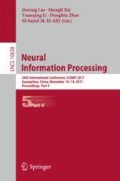Abstract
Sentiment classification is a useful approach to analyse the emotional polarity of user reviews, and method based on machine learning has achieved a great success. In the era of Web2.0, the emotional intensity of terms will change with time and events, while a large number of Out-Of-Vocabulary (OOV) terms are appearing. But the method of machine learning pays little attention to them because they focus to reduce the computational complexity. To address the problem, we proposed a dynamic forest model, which can describe the emotional intensity of the term in character granularity, and can append OOV dynamically and adjust their emotional intensity value. Experiments show that in the Chinese environment, our model greatly boosts the performance compared with the method based machine learning, while the time is saved by halves.
References
Abbasi, A., Chen, H., Salem, A.: Sentiment analysis in multiple languages: feature selection for opinion classification in web forums. ACM Trans. Inf. Syst. (TOIS) 26(3), 12 (2008)
Pang, B., Lee, L., et al.: Opinion mining and sentiment analysis. Found. Trends\(\textregistered \) Inf. Retrieval 2(1–2), 1–135 (2008)
Liu, B., Zhang, L.: A survey of opinion mining and sentiment analysis. In: Aggarwal, C., Zhai, C. (eds.) Mining Text Data, pp. 41–463. Springer, Heidelberg (2012). doi:10.1007/978-1-4614-3223-4_13
Vinodhini, G., Chandrasekaran, R.: Sentiment analysis and opinion mining: a survey. Int. J. 2(6), 282–292 (2012)
Taboada, M., Brooke, J., Tofiloski, M., Voll, K., Stede, M.: Lexicon-based methods for sentiment analysis. Comput. Linguist. 37(2), 267–307 (2011)
Yong-Mei, Z., Yang Jia-Neng, Y.A.M.: A method on building Chinese sentiment Lexicon for text sentiment analysis. J. ShanDong Univ. (Eng. Sci.) 43(6), 27–33 (2013)
Kouloumpis, E., Wilson, T., Moore, J.D.: Twitter sentiment analysis: the good the bad and the OMG! Icwsm 11(538–541), 164 (2011)
Paltoglou, G., Thelwall, M.: A study of information retrieval weighting schemes for sentiment analysis. In: Proceedings of the 48th Annual Meeting of the Association for Computational Linguistics, pp. 1386–1395. Association for Computational Linguistics (2010)
Pak, A., Paroubek, P.: Twitter as a corpus for sentiment analysis and opinion mining. In: LREc, vol. 10 (2010)
Vo, D.T., Zhang, Y.: Target-dependent Twitter sentiment classification with rich automatic features. In: IJCAI, pp. 1347–1353 (2015)
Sriram, B., Fuhry, D., Demir, E., Ferhatosmanoglu, H., Demirbas, M.: Short text classification in Twitter to improve information filtering. In: Proceedings of the 33rd International ACM SIGIR Conference on Research and Development in Information Retrieval, pp. 841–842. ACM (2010)
Banerjee, S., Ramanathan, K., Gupta, A.: Clustering short texts using Wikipedia. In: Proceedings of the 30th Annual International ACM SIGIR Conference on Research and Development in Information Retrieval, pp. 787–788. ACM (2007)
Tang, D., Wei, F., Yang, N., Zhou, M., Liu, T., Qin, B.: Learning sentiment-specific word embedding for Twitter sentiment classification. In: ACL, vol. 1, pp. 1555–1565 (2014)
Shoushan, L., ChuRan, H.: Chinese sentiment classification based on stacking combination method. J. Chin. Inf. Process. 24(5), 56–61 (2010)
Yang, D., Yang, A.M.: Classification approach of Chinese texts sentiment based on semantic Lexicon and naive Bayesian. Jisuanji Yingyong Yanjiu 27(10) (2010)
Jie, J., Rui, X., et al.: Microblog sentiment classification via combining rule-based and machine learning methods. Acta Scientiarum Naturalium Universitatis Pekinensis 53(2), 247–254 (2017)
Li, L., Cao, D., Li, S., Ji, R.: Sentiment analysis of Chinese micro-blog based on multi-modal correlation model. In: 2015 IEEE International Conference on Image Processing (ICIP), pp. 4798–4802. IEEE (2015)
Acknowledgments
We would like to thank Sougou for its news data.
Author information
Authors and Affiliations
Corresponding author
Editor information
Editors and Affiliations
Rights and permissions
Copyright information
© 2017 Springer International Publishing AG
About this paper
Cite this paper
Li, M., Dai, J., Liu, W., Han, J. (2017). Dynamic Forest Model for Sentiment Classification. In: Liu, D., Xie, S., Li, Y., Zhao, D., El-Alfy, ES. (eds) Neural Information Processing. ICONIP 2017. Lecture Notes in Computer Science(), vol 10638. Springer, Cham. https://doi.org/10.1007/978-3-319-70139-4_21
Download citation
DOI: https://doi.org/10.1007/978-3-319-70139-4_21
Published:
Publisher Name: Springer, Cham
Print ISBN: 978-3-319-70138-7
Online ISBN: 978-3-319-70139-4
eBook Packages: Computer ScienceComputer Science (R0)

